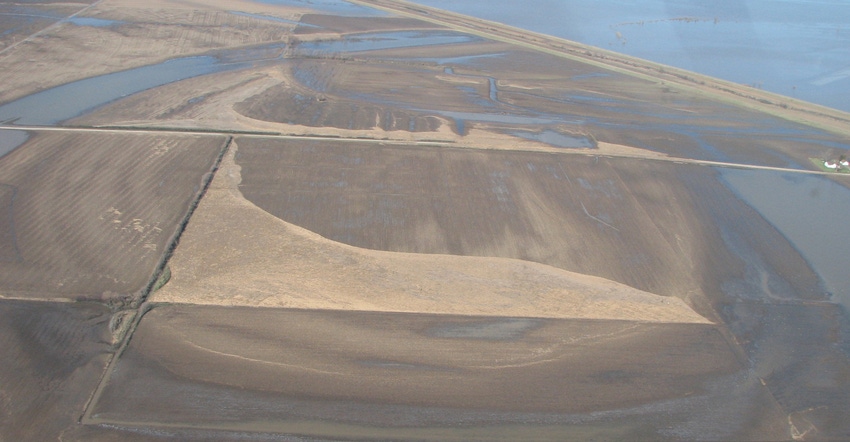
In the aftermath of extreme flooding events in Nebraska this spring, landowners are faced with not only sand, silt and debris deposited on their land, but also with large amounts of corn residue from upstream — piled 3 feet deep on some fields. Meanwhile, many growers are dealing with stored grain and hay damaged by flooding.
"For the most part, we didn't have the soil erosion like we had in 2011 because the ground was frozen and the duration of the flooding was much shorter," says John Wilson, Nebraska Extension educator in Burt County. “But there wasn't any place for water to go, so it ran off. It washed off in a hurry and washed away all these cornstalks, and they accumulated everywhere."
As growers clean up, the question is: What do you do with all this grain, crop residue and hay affected by flooding?
Wilson notes anytime debris, residue, grain or hay are exposed to floodwater, it must be considered contaminated — and there's no way to test for it. This poses a bigger challenge for recreational and residential areas, where the only way the debris can legally be disposed of is through a landfill. For agricultural landowners, there are a few additional options.
"As long as the ground is zoned agriculturally, you can burn residue, land-apply it and incorporate it, compost it, or it can also be hauled to a C&D [construction and demolition] landfill," Wilson says.
"Some landowners are either leaving stalks spread out in the hopes they'll dry out enough to burn them, or push them in a pile and stockpile them in a corner of the field, minimizing the amount of ground taken out of production, and deal with them later," Wilson adds. "After harvest, they may spread stalks back on the field — that's one way to deal with them if they don't want to or can't burn them."
In many cases, burning won't be a viable option — the residue will be too wet.
Erik Waiss, Nebraska Department of Environmental Quality (NDEQ) environmental assistance coordinator, says residue can be transported through contiguous property — including across a county road to adjacent fields — but not off the property.
"However, once it's composted, that material is more or less a product — you can take it wherever you need to use it," Waiss says. "Composting implies a certain amount of attention given to the waste pile, as opposed to it sitting and rotting. That means turning the pile and making sure it's getting aerated."
Rick Koelsch, Nebraska Extension biological systems engineer, notes more often, corn residue will be used as a carbon source for composting other things — such as flood-damaged hay or grain.
And, Koelsch says although growers can land-apply and incorporate flood-affected grain, it's probably a better idea to compost it first.
"Corn is going to have herbicide-resistant traits in it — you really don't want that to sprout next summer in your soybean field,” he says. “You'll have a mess of volunteer corn that's very difficult to handle. We hope that by heating those seeds up, we can reduce the chance those seeds will sprout."
However, corn grain often will dry down to 25% to 30% moisture even after being affected by flooding — and may be too dry for composting. So, it's best to mix it with something such as wet hay or corn residue, if wet enough. The ideal moisture content for composting is 40% to 60% moisture.
The composting process involves windrowing or piling materials together, and monitoring the temperature closely.
"After the pile is put together, it will rise to 150 or 160 degrees F,” Koelsch explains. “The temperature will stabilize as the pile uses up oxygen, and then it will slowly drop. When it drops to 100 to 120 degrees, you should turn that pile again to give it more oxygen. On the other side, if we're working with wet hay, and it gets above 160 degrees, I would flip the pile to cool it. Once hay gets up to 170 to 180 degrees, it can spontaneously combust."
Typically, flipping the pile once is sufficient to get an acceptably composted product.
Another challenge is determining the value of the product that's being applied. When it comes to flood-damaged grain, composting it ahead of time to prevent herbicide-resistant volunteer corn from sprouting is benefit enough. But what about composted hay and forage?
"Our biggest challenge with organic sources of nutrients is predicting what becomes available to the crop during the growing season,” Koelsch says. “Our suggestion is only applying in fields where you can check the N status of the crop in the early part of the growing season and have the ability to sidedress N if the crop is showing N stress. We might be able to count on 50% of the N in the hay or corn being available to the crop in the first year — but that's just an educated guess."
"Use good judgment and common sense,” Koelsch adds. “We're dealing with a set of challenges we don't have a lot of experience with. If you're land-applying, I would give NDEQ a call, let them know what you're doing and emphasize that you are land-applying at an agronomic rate preferably based upon the nitrogen in the organic product."
About the Author(s)
You May Also Like






